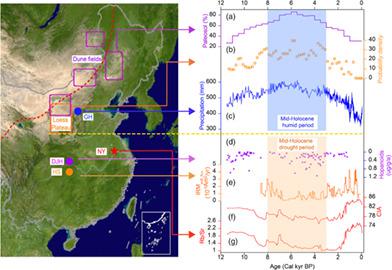当前位置:
X-MOL 学术
›
Int. J. Climatol.
›
论文详情
Our official English website, www.x-mol.net, welcomes your feedback! (Note: you will need to create a separate account there.)
Dipolar mode of precipitation changes between north China and the Yangtze River Valley existed over the entire Holocene: Evidence from the sediment record of Nanyi Lake
International Journal of Climatology ( IF 3.9 ) Pub Date : 2020-10-24 , DOI: 10.1002/joc.6906 Jianbao Liu 1, 2, 3 , Zhongwei Shen 3 , Wei Chen 4 , Jie Chen 3 , Xu Zhang 2, 3 , Jianhui Chen 3 , Fahu Chen 1, 2, 3
International Journal of Climatology ( IF 3.9 ) Pub Date : 2020-10-24 , DOI: 10.1002/joc.6906 Jianbao Liu 1, 2, 3 , Zhongwei Shen 3 , Wei Chen 4 , Jie Chen 3 , Xu Zhang 2, 3 , Jianhui Chen 3 , Fahu Chen 1, 2, 3
Affiliation

|
Instrumental data indicate the occurrence of a dipolar pattern of precipitation anomalies between north China and the Yangtze River Valley (YRV), which was termed “northern drought (flood)—southern flood (drought)” scenario. It has been shown that this pattern occurred during the Medieval Climate Anomaly (MCA) and the Little Ice Age (LIA). However, there are questions about whether this dipolar pattern also occurred during the entire Holocene, and the mechanism responsible. Addressing these questions is of fundamental importance for understanding the spatiotemporal evolution of precipitation in East Asian summer monsoon region. Numerous studies of north China have demonstrated that the mid‐Holocene was humid, and the early and late Holocene were dry. However, there are relatively few equivalent studies in the YRV. To this end, we conducted detailed geochemical analysis of an AMS 14C‐dated sediment core from Lake Nanyi in the YRV. Our results indicate humid periods at Lake Nanyi occurred during 11.5–8.0 ka and from 2.0 ka to the present, while dry conditions occurred during ~8.0–2.0 ka. These results, together with published records from Dajiuhu peatland and Heshang Cave, collectively indicate in the YRV, the mid‐Holocene (~8.0–3.0 ka) was dry, while the early and late Holocene were humid, which is the inverse of the pattern in north China. Thus, we conclude there was an asynchronous evolution of hydroclimatic changes between north China and the YRV during the Holocene. We interpret this dipolar pattern as the result of ENSO variations: in a La Niña‐like state, the Western Pacific Subtropical High retreated northeastward, which would enable the rainfall belt to move northward and result in increased (decreased) precipitation in north China (the YRV). Sea surface temperature records from the Pacific Ocean and model simulations support this mechanism: a La Niña‐like state in the mid‐Holocene resulted in more (less) precipitation in north China (the YRV).
更新日期:2020-10-24


























 京公网安备 11010802027423号
京公网安备 11010802027423号